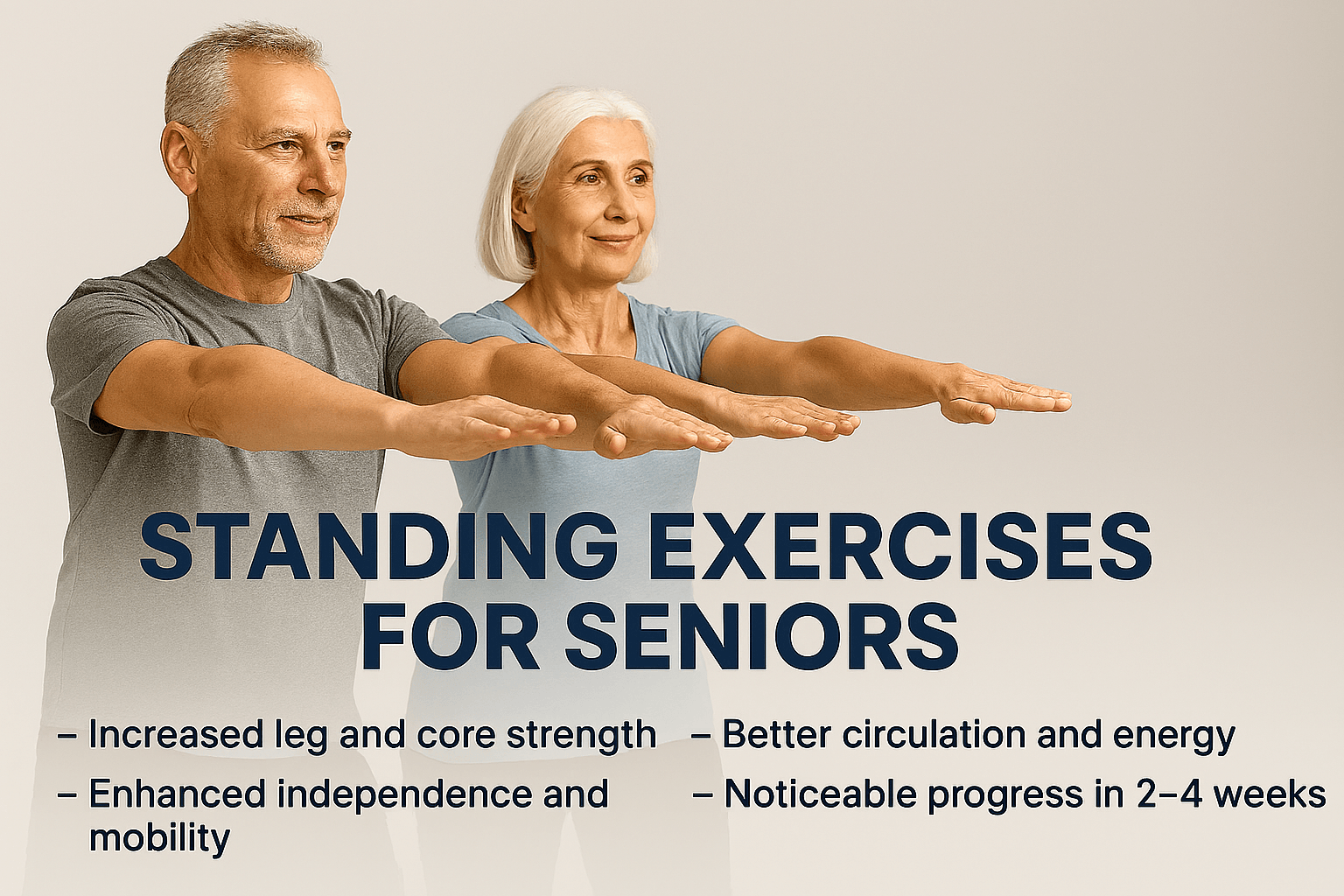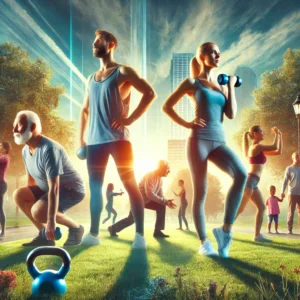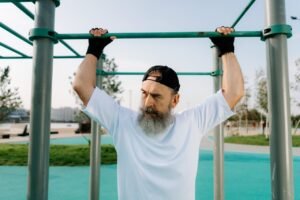Last Updated on October 3, 2025 by shawnshealth
7 powerful standing exercises for seniors to build strength, balance, and confidence safely!
🧓 7 Powerful Standing Exercises for Seniors to Build Strength and Stability
Standing exercises for seniors are a vital progression from chair-based routines. As older adults build foundational strength through seated movements, transitioning to standing exercises helps improve balance, coordination, and overall mobility. These exercises activate more muscle groups, support posture, and reduce the risk of falls—all without requiring expensive equipment or gym access.
For seniors who’ve completed chair workouts and are ready to move forward, standing exercises offer a safe and effective way to stay strong and independent. Whether you’re managing arthritis, recovering from injury, or simply looking to stay active, these movements are designed to meet you where you are.
👉 For a deeper understanding of how strength, mobility, and balance work together, explore our Senior Fitness: 15 Essential Principles—a foundational guide to aging well through movement.
👉 Start with our Chair Exercises for Seniors series if you’re new to fitness or need seated support.
🎬 Quick Start to Standing Strength Want to see these exercises in action? This short video walks you through safe, effective standing movements that build strength, balance, and confidence—perfect for older adults ready to move beyond the chair.
⭐ Quick Answers for Senior Fitness Progression
- Standing exercises for seniors improve strength, balance, and fall prevention.
- No equipment is needed—just a wall, chair, or open space.
- Start with low reps and increase gradually for safe progression.
- Standing exercises for seniors support posture, coordination, and independence.
What Makes Standing Exercises Ideal for Seniors?
- Engage multiple muscle groups
- Improve posture and coordination
- Support safe progression from seated routines
- Require no equipment or gym access
How Standing Movements Help Prevent Falls
- Strengthen stabilizing muscles
- Improve reaction time and balance
- Reinforce joint control and mobility
- Build confidence in daily movement
When Should Seniors Start Standing Workouts?
- After mastering chair-based exercises
- When balance allows safe upright movement
- With medical clearance if recovering from injury
- At any age—starting slow is key
What to Expect From a Standing Routine
- Increased leg and core strength
- Better circulation and energy
- Enhanced independence and mobility
- Noticeable progress in 2–4 weeks
📑Table of Contents
⚠️ Disclaimers
Medical Disclaimer: This content is for informational purposes only and does not substitute professional medical advice. Always consult your healthcare provider before starting a new exercise routine.
Affiliate Disclosure: This post contains affiliate links. As an Amazon Associate, we earn from qualifying purchases at no extra cost to you.
🛒 Helpful Gear to Get You Started
Looking to support your standing exercise routine with safe, senior-friendly equipment? 👉 Browse fitness gear on Amazon—resistance bands, stability tools, and more
📊 Reps, Sets & Progression Table
| Level | Reps | Sets | Progression Tip |
|---|---|---|---|
| Beginner | 8–10 | 1–2 | Use wall or chair for support |
| Intermediate | 10–15 | 2–3 | Increase range of motion |
| Advanced | 15–20 | 3–4 | Add light resistance (bands or weights) |
AUTHOR’S NOTE: These are all suggestions and a good way to develop your progressions. However, we are all different individuals, and you may find it useful, after some time, to alter things to your personal needs. You may find that your goals and what makes you feel best in your workout practice may be different than another person. You may want to do few sets but attempt to do many reps during each set. Or you may want to do fewer reps per set but focus more on slower speed and increasing exercise difficulty. Take your time, be consistent, journal, and then figure out what works best for you for now.
🏋️ 7 Standing Exercises for Seniors
These standing exercises for seniors are designed to improve strength, balance, and mobility. Each movement includes a description, safety tip, image suggestion, and progression advice.
1. Wall Push-Offs
Description: Stand facing a wall with hands shoulder-width apart. Lean in slightly and push off gently to return to standing. Muscles Targeted: Chest, shoulders, triceps Safety Tip: Keep feet flat and maintain upright posture. Progression: Step farther from the wall for more resistance.
👉 Want to build strength that supports everyday movement? Explore our guide to Functional Strength for Seniors—featuring practical exercises that improve stability, coordination, and real-world mobility.
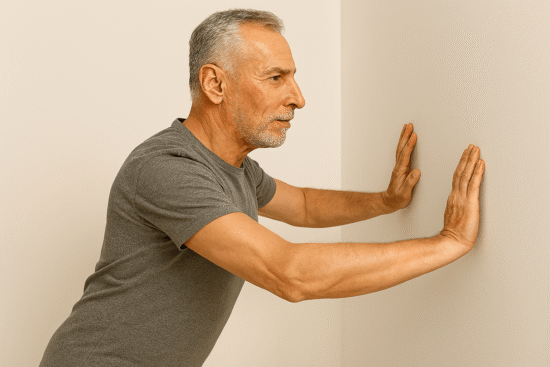
2. Standing Marches
Description: Lift one knee at a time in a slow, controlled march. Keep arms relaxed or slightly raised for balance. Muscles Targeted: Hip flexors, core, legs Safety Tip: Use a chair or wall for support if needed. Progression: Increase duration or add ankle weights.
👉 For a deeper look at how simple movements like marching in place can improve balance, coordination, and confidence, check out this guide from Leading Edge Senior Care: 5 Best Exercises to Help Seniors With Balance. It’s packed with practical tips and progression strategies tailored for older adults.
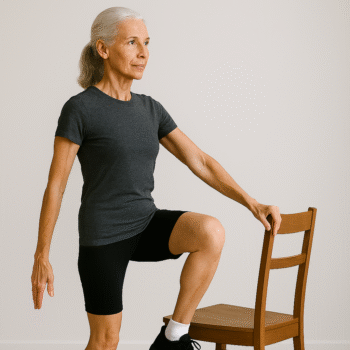
3. Heel-to-Toe Walk
Description: Walk in a straight line placing heel directly in front of the toe with each step. Muscles Targeted: Ankles, calves, core Safety Tip: Perform near a wall or hallway for support. Progression: Try walking backward or on a soft surface.
🚶♀️ Boost Balance with Heel-to-Toe Walking Life Assure’s guide shows how heel-to-toe walking helps seniors improve stability, coordination, and fall prevention with just minutes of daily practice.
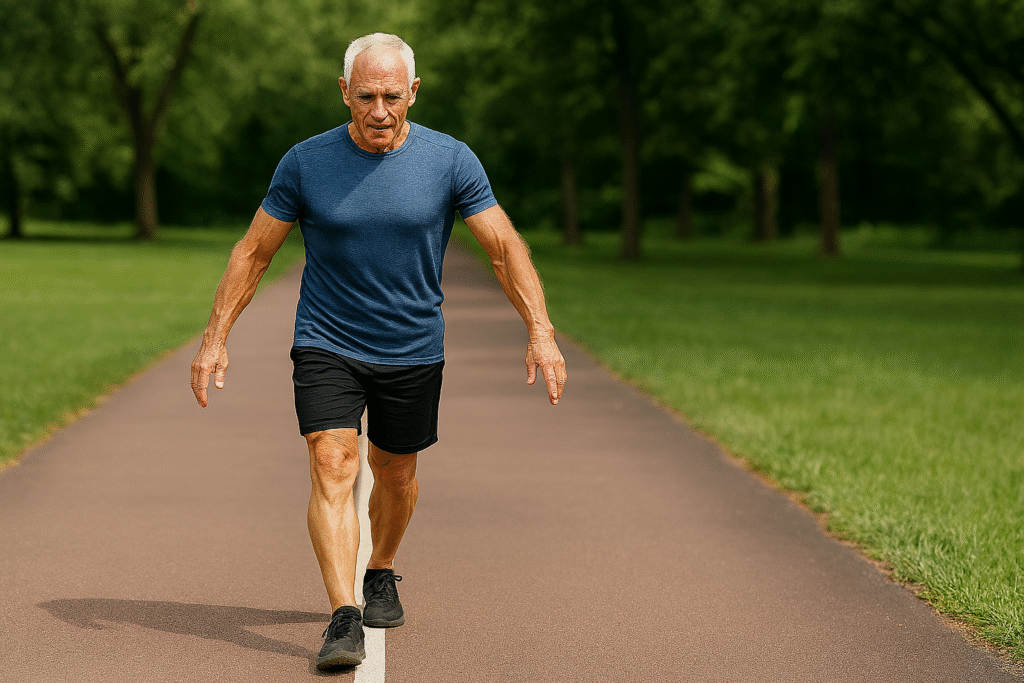
4. Standing Calf Raises
Description: Stand tall and lift heels off the ground, then lower slowly. Muscles Targeted: Calves, ankles Safety Tip: Keep knees soft and avoid locking joints. Progression: Add resistance bands or hold dumbbells.
🦵 Strengthen Calves for Better Mobility Elder Strength’s calf raise guide explains how this simple exercise improves walking, circulation, and ankle stability—especially important for older adults.
5. Side Leg Lifts
Description: Stand tall and lift one leg out to the side, keeping torso upright. Muscles Targeted: Glutes, hips, core Safety Tip: Avoid leaning—engage core for stability. Progression: Add ankle weights or increase hold time.
🪑 Building on Lateral Movement from the Chair Ready to progress from seated leg lifts? Our Advanced Chair Exercises for Seniors introduce lateral control and core engagement—perfect prep for standing side leg lifts.
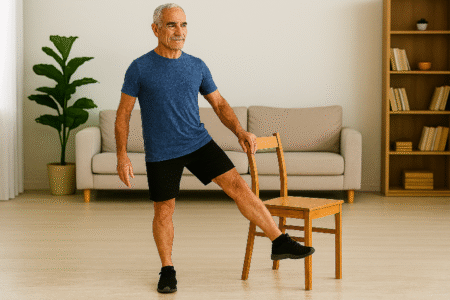
6. Mini Squats
Description: Stand with feet shoulder-width apart, bend knees slightly, then return to standing. Muscles Targeted: Quads, hamstrings, glutes Safety Tip: Keep knees aligned with toes, avoid deep squats. Progression: Hold dumbbells or increase depth gradually.
🧍♀️ NIH Endorses Squats for Lower Body Strength The National Institutes of Health recommends squats to help older adults build leg strength, support mobility, and maintain independence through safe, functional movement.
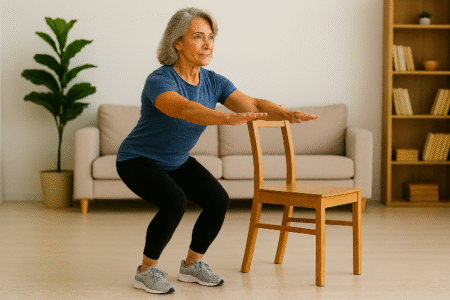
7. Arm Circles While Standing
Description: Extend arms to sides and make small circles forward and backward. Muscles Targeted: Shoulders, upper back Safety Tip: Keep shoulders relaxed and avoid straining. Progression: Increase duration or add light wrist weights.
💪 Ready to Build Lasting Strength? Standing exercises are a great start—but for full-body results, explore our Strength Training for Seniors guide. It covers safe, effective ways to boost muscle, mobility, and independence at any age.
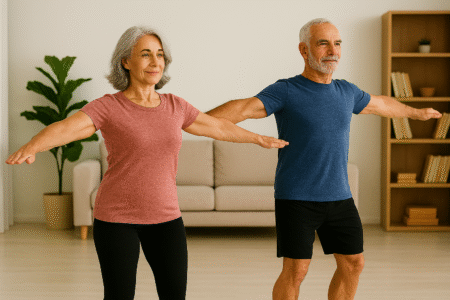
✅ Conclusion: Standing Exercises for Seniors
Standing exercises for seniors are a powerful way to build strength, improve balance, and maintain independence. These movements support posture, coordination, and fall prevention—all critical for aging well. By starting with low-impact, bodyweight movements and progressing gradually, seniors can safely transition from seated routines to full mobility.
Consistency is key. Practicing these standing exercises for seniors 2–3 times per week can lead to noticeable improvements in strength, stability, and confidence. Whether you’re working out at home or in a group setting, these exercises are accessible, effective, and empowering.
🛒 Recommended Gear: 👉 Explore senior-friendly home gym gear at Amazon
🔗 Continue Your Senior Fitness Journey
- Chair Exercises for Seniors
- Functional Strength for Seniors
- Bodyweight Strength Training for Seniors at Home
- Senior Fitness Principles
❓ FAQ: Standing Exercises for Seniors
1. What are the benefits of standing exercises for seniors?
- Improved balance and coordination
- Increased leg and core strength
- Reduced fall risk
2. How often should seniors do standing exercises?
- 2–3 times per week is ideal for beginners
- Can increase frequency as strength improves
3. Do I need equipment for these exercises?
- No equipment is required
- Optional: resistance bands or light weights
4. Are these exercises safe for seniors with arthritis?
- Yes, but start slow and consult your doctor
- Avoid deep squats or high-impact movements
5. Can I modify these exercises if I have limited mobility?
- Yes—use a chair or wall for support
- Reduce range of motion as needed
6. How long should each session last?
- 15–20 minutes is a great starting point
- Focus on quality over quantity
7. What should I wear during standing workouts?
- Supportive shoes with good grip
- Comfortable, breathable clothing
8. How do I know when to progress?
- You’re ready to add light resistance or increase range of motion
- Exercises feel easier and more controlled
- You complete all reps and sets without fatigue
- Balance and coordination noticeably improve
📣 Ready to Take That Next Step?
🧠Standing exercises for seniors are a powerful way to stay strong, steady, and independent. Whether you’re just starting out or building on chair-based routines, these movements offer a safe and effective path forward.
🦉Explore more senior-friendly workouts, gear recommendations, and progression guides at ShawnsHealth.com—your trusted resource for aging well, staying active, and living confidently.
Therefore encourage one another and build each other up. – I Thessalonians 5:11

